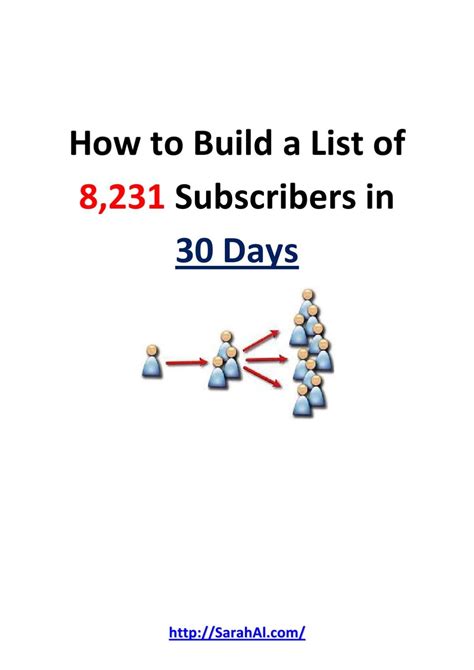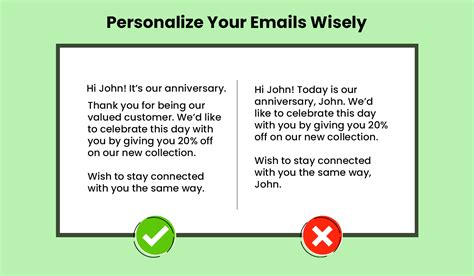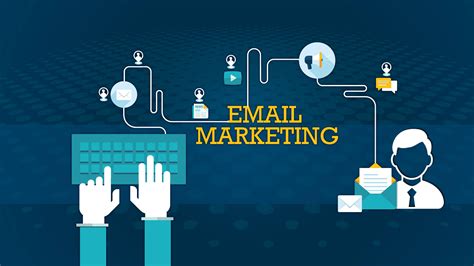Unlock the potential of your online marketing efforts and learn how to captivate your audience with a flawless email communication strategy. When it comes to building strong connections and engaging your target audience, nothing beats the power of a well-crafted email message. In this article, we will delve into the top 10 techniques that will help you take your email communication game to the next level.
1. Craft compelling subject lines: Imagine the subject line as the gateway to your email. Make it irresistible by using attention-grabbing phrases that pique curiosity and evoke emotions. Emphasize the value your email provides and make it clear why your recipient should invest their time in reading it.
2. Personalize your content: Gone are the days of generic mass emails. Show your recipients that you see them as individuals and not just another name on your list. Address them by their first name and tailor your content to their preferences and interests. This personalized touch will go a long way in establishing a genuine connection.
3. Keep it concise and relevant: Time is a precious resource, and your readers won't appreciate lengthy emails that beat around the bush. Cut to the chase and deliver your message succinctly. Only include information that is relevant to your audience, and avoid unnecessary fluff that will cause them to lose interest.
4. Use compelling visuals: Humans are visual creatures, and email messages that feature eye-catching graphics and images are more likely to capture attention. Incorporate visually appealing elements that complement your message and enhance its impact. Remember to optimize your images to ensure quick loading times.
5. Provide a clear Call-to-Action (CTA): Don't assume that your recipients will know what action to take after reading your email. Clearly state your desired outcome and guide them towards it. Whether it's making a purchase, subscribing to a service, or signing up for an event, a well-crafted CTA will encourage your readers to take the next step.
6. Test and analyze: Never settle for mediocrity when it comes to email marketing. Continuously test different strategies, subject lines, layouts, and content to see what generates the best results. Analyze the data to gain insights into your audience's preferences and behavior, enabling you to refine your approach for future campaigns.
7. Segment your audience: Not all subscribers are the same, and sending a one-size-fits-all message will not yield maximum impact. Segment your audience based on factors such as demographics, geography, previous purchases, or engagement levels, and target each segment with tailored content that speaks directly to their needs and desires.
8. Perfect your timing: Timing is crucial in email marketing. Sending your message at the right moment can significantly increase open and click-through rates. Experiment with different send times and analyze the response to find the optimal timing for your audience. Keep in mind factors like time zones and work schedules to ensure your message doesn't get lost in a crowded inbox.
9. Build trust with authenticity: Building trust is the foundation of any successful email communication strategy. Be genuine and transparent in your messaging, ensuring that your subscribers feel valued and respected. Avoid using overly salesy language and focus on establishing yourself as a reliable source of valuable information.
10. Monitor and adapt: The digital landscape is ever-evolving, and what may have worked yesterday might not work today. Continuously monitor your email marketing efforts, keep an eye on industry trends, and adapt your strategy accordingly. Stay up-to-date with the latest tools and techniques to ensure that your email communication stays fresh and impactful.
By following these tips, you will be well on your way to mastering the art of effective email communication. Unlock the true potential of email marketing and watch as your efforts translate into increased engagement, conversions, and lasting customer relationships.
Building a Focused List of Subscribers

Developing an exclusive group of engaged subscribers is a valuable asset for any email marketing campaign. This segment of individuals who have willingly subscribed to receive emails from your business holds the potential for higher open rates, click-through rates, and ultimately, conversions. In this section, we will explore effective strategies to build a targeted subscriber list.
1. Identify Your Target Audience: Determine the demographics, interests, and preferences of your ideal subscribers. This information will help you tailor your email content and communication style to resonate with your target audience.
2. Craft an Appealing Lead Magnet: Offer an enticing incentive, such as an exclusive eBook, discount code, or informative video, in exchange for visitors' email addresses. This tactic encourages website visitors to willingly sign up for your email list.
3. Optimize Sign-Up Forms: Place prominent sign-up forms on your website and landing pages to capture visitors' attention. Keep the form simple, asking for essential information like name and email address.
4. Leverage Social Media: Promote your email subscription through various social media platforms to reach a wider audience. Use engaging content and compelling visuals to drive users to your sign-up page.
5. Implement Double Opt-In: Use a double opt-in method to confirm subscribers' intent and ensure the validity of email addresses. This process eliminates the risk of fake or mistyped email addresses, resulting in a more engaged subscriber list.
6. Personalize Communication: Address subscribers by their first name and segment your email list based on their preferences and behaviors. This personalized approach demonstrates that you value their individual needs and interests.
7. Create Valuable Content: Consistently provide relevant and valuable content to your subscribers. This can include educational articles, industry insights, product updates, or exclusive offers. Establishing yourself as a trusted source of information will help retain subscribers and encourage them to share your emails with others.
8. Encourage Referrals: Incentivize your existing subscribers to refer their friends and colleagues to join your email list. Offer rewards or exclusive content as a token of appreciation for their referrals, effectively expanding your targeted subscriber base.
9. Optimize Mobile Experience: Ensure that your emails and sign-up forms are mobile-friendly. With a growing number of users accessing emails on their mobile devices, an optimized mobile experience is crucial to engage and retain subscribers.
10. Regularly Clean and Update Your List: Periodically review your email list to remove inactive or unsubscribed subscribers. Keeping your list up-to-date and relevant ensures that your email marketing efforts are focused on an engaged audience.
Crafting Irresistible Subject Lines
In the realm of email marketing, the ability to craft captivating subject lines holds immense power. With a subject line being the first point of contact for recipients, it acts as a gateway to generating interest, increasing open rates, and ultimately driving conversions. This section will explore effective techniques for crafting subject lines that truly captivate and compel.
1. Grab attention with curiosity: Spark curiosity by teasing a valuable offer or intriguing content within the subject line. Leave readers wanting more and eager to open your email.
2. Incorporate personalization: Tailor subject lines to individual recipients, utilizing their name or other relevant information. This personal touch creates a sense of familiarity and connection.
3. Create a sense of urgency: By highlighting limited-time offers or exclusive deals, subject lines can instill a sense of urgency, encouraging readers to act quickly and take advantage of the opportunity.
4. Use power words: Energize subject lines by incorporating strong and impactful words like "exclusive," "secret," "must-have," or "limited." These words evoke curiosity and desire in the minds of recipients.
5. Keep it concise: Aim for subject lines that are short and to the point. Long subject lines can get cut off or lose impact in crowded inboxes.
6. Emphasize relevance: Make sure the subject line clearly conveys the value or benefit to the recipient. Relevance is key to catching their attention and motivating them to open the email.
7. Leverage social proof: Incorporate social proof elements such as customer reviews, success stories, or impressive statistics within the subject line. This helps build trust and credibility, enticing readers to explore further.
8. Test and analyze: Experiment with different subject lines to gauge their effectiveness. Analyze open rates and click-through rates to identify the styles and approaches that resonate best with your audience.
9. Emphasize exclusivity: Use subject lines that create a sense of exclusivity or VIP treatment for recipients. People often value and respond positively to feeling special or privileged.
10. Avoid spammy language: Steer clear of spam triggers, such as excessive capitalization, excessive punctuation, or misleading claims. Craft subject lines that genuinely reflect the content and purpose of the email.
Mastering the art of crafting compelling subject lines is crucial for achieving email marketing success. By implementing these strategies, you can increase the chances of capturing your audience's attention and driving engaging interactions with your emails.
Personalize Your Emails

Customizing your email communication is vital to establish a deeper connection with your recipients and enhance the overall effectiveness of your email marketing efforts. By tailoring your messages to suit the individual needs and preferences of your target audience, you can significantly improve engagement, increase open rates, and drive conversions.
- Segment Your Email List: Divide your subscribers into different groups based on their demographics, interests, purchase history, or any other relevant criteria. This segmentation allows you to send more targeted and personalized emails, ensuring that recipients receive content that is specifically relevant to them.
- Address Recipients by Name: A simple yet powerful way to personalize your email is to address each recipient by their name. Using their name in the subject line or greeting instantly grabs their attention and helps create a more personal connection.
- Offer Personalized Recommendations: Leverage customer data and behavior to provide personalized product recommendations or content suggestions. By understanding their past purchases or browsing history, you can deliver relevant and valuable recommendations that resonate with recipients.
- Use Dynamic Content: Implement dynamic content elements within your emails to deliver personalized information. This can include tailored product offers, special discounts, or targeted messaging based on recipients' preferences or actions.
- Send Triggered Emails: Set up automated campaigns triggered by specific actions or events, such as a welcome email when someone signs up or a follow-up email after a purchase. These triggered emails provide timely and personalized communication that strengthens the relationship with your subscribers.
- Include Personalized Subject Lines: Craft subject lines that capture recipients' attention and resonate with their needs. Experiment with using their location, recent activity, or purchase history to create personalized subject lines that stand out in crowded inboxes.
- Customize Sender Names and Email Addresses: Maintain consistency in your email communications by customizing the sender name and email address to match your brand. This adds a personal touch and ensures that recipients can easily recognize and trust your emails.
- Optimize for Mobile Devices: With the increasing use of mobile devices, it is crucial to optimize your emails for mobile viewing. Ensure that your emails are mobile-friendly, responsive, and easy to navigate to provide a seamless and personalized experience for mobile users.
- Encourage Feedback and Engagement: Include interactive elements, such as surveys, polls, or social media buttons, to encourage recipients to provide feedback or engage with your brand. By actively involving your audience, you can gather valuable insights and strengthen the personal connection.
- Analyze and Refine: Regularly analyze the results of your email campaigns to identify areas for improvement and refine your personalization strategies. Pay attention to metrics like open rates, click-through rates, and conversions to optimize your future email marketing efforts.
Enhance Your Email Content to Maximize Results
When it comes to optimizing your email content, there are several key strategies that can help you achieve impressive results. By carefully crafting every element of your email messages, from the subject line to the call-to-action, and making use of persuasive language and engaging visuals, you can truly ensure that your email marketing efforts drive high open rates, clicks, and conversions.
Avoid Bland Subject Lines: Catch your readers' attention right from their inboxes by crafting compelling subject lines that entice them to open your emails. Experiment with different approaches like posing intriguing questions or creating a sense of urgency to stand out in a crowded inbox.
Create Engaging Preheaders: Don't miss the opportunity to provide a short preview of what your email has to offer with an attention-grabbing preheader. Tease your subscribers and make them eager to dive into the content of your email.
Personalize Your Emails: Make your subscribers feel valued by addressing them by their names and tailoring the content to their specific interests or preferences. This personal touch can significantly improve engagement and conversion rates.
Utilize Compelling Visuals: Capture your readers' attention with visually appealing images that complement your email content. Use high-quality and relevant visuals to convey your message effectively, making your emails more visually stimulating and memorable.
Keep Your Emails Concise: In today's fast-paced world, people receive countless emails every day. To ensure your message gets across, keep your emails concise and to the point. Use clear and succinct language to deliver your key points effectively, maintaining your readers' interest throughout.
Include Clear Call-to-Actions: Guide your subscribers towards the desired action by incorporating clear and compelling call-to-actions. Use action-oriented language and provide easy-to-spot buttons or links that prompt your readers to take the next step, whether it's making a purchase, signing up for a webinar, or downloading a resource.
Optimize for Mobile: With the majority of emails being opened on mobile devices, it's crucial to ensure that your email content looks great and functions seamlessly on smartphones and tablets. Optimize your email design for mobile responsiveness, making it easy for your subscribers to engage with your content on the go.
Test and Analyze: Continuously test different elements of your email content, including subject lines, visuals, and calls-to-action, to identify what resonates best with your audience. Monitor your email analytics to gather insights and make data-driven decisions to optimize your future campaigns.
Inject Personality and Authenticity: Stand out from the competition and create a connection with your subscribers by infusing your email content with personality and authenticity. Let your brand's voice shine through and establish trust by being transparent and genuine in your communication.
Segment and Target: Leverage the power of segmentation to deliver more personalized and relevant content to your subscribers. By grouping your audience based on demographics, interests, or past interactions, you can send targeted emails that resonate with specific segments, leading to higher engagement and conversion rates.
By applying these email content optimization strategies, you can enhance the effectiveness of your email marketing and achieve greater success in capturing your audience's attention, driving engagement, and ultimately, achieving your marketing goals.
Enhancing Engagement with Visuals

In the world of digital communication, incorporating visual elements can significantly enhance the impact and engagement of your email marketing campaign. By incorporating visually appealing images, videos, and infographics, you can captivate your audience's attention, evoke emotions, and convey your message in a more captivating and memorable way.
Visuals have the power to break through the clutter of text and make your email stand out in a crowded inbox. They can help to create a visual hierarchy, guiding the reader's eye to key information and calls to action. Whether it's a striking header image, an eye-catching product photograph, or an informative chart, visuals can instantly grab attention and entice the recipient to continue reading.
Additionally, visual elements can be used strategically to reinforce your brand identity and establish a consistent visual language across all your marketing channels. Incorporating your logo, brand colors, and typography in your visuals can help create a cohesive and recognizable brand experience for your subscribers.
When using visuals in email marketing, it is essential to optimize them for different devices and email clients. This ensures that your visuals are displayed correctly and do not disrupt the overall user experience. Consider using responsive design techniques and compressing images to reduce loading time and improve email deliverability.
Remember to include alternative text descriptions for your visuals, as some email clients may block images by default. This will ensure that even if the visuals are not displayed, the recipient still gets a clear understanding of your message and can take action accordingly.
Lastly, be mindful of the file sizes of your visuals, as large attachments can contribute to slow loading times and potentially harm your email deliverability. Use appropriate image compression techniques and consider hosting larger files externally, if necessary, to maintain optimal performance.
| Benefits of using visuals in email marketing: |
|---|
| 1. Increased attention and engagement |
| 2. Enhanced brand recognition |
| 3. Improved visual hierarchy and information presentation |
| 4. Consistent and cohesive branding |
| 5. Responsive design for various devices |
| 6. Alternative text descriptions for accessibility |
| 7. Optimized file sizes for better performance |
Implement a Compelling Call to Action
Encourage readers to take action with a clear and effective call to action in your email marketing campaigns. By providing a strong and compelling message, you can motivate your audience to engage further with your content, make a purchase, or complete a desired action.
Make sure your call to action stands out by using eye-catching design elements, such as bold fonts or contrasting colors. Use persuasive language that inspires urgency and creates a sense of excitement or curiosity. Emphasize the value of the action you want your readers to take and highlight any benefits or incentives they will receive by doing so.
Consider the placement of your call to action within your email. Position it prominently and ensure it is easily accessible, allowing readers to take immediate action without having to scroll or search for it. Experiment with different placement options and monitor the performance to optimize your results.
Use action-oriented verbs to prompt a response, such as "Shop now," "Sign up," or "Learn more." These strong and specific words will encourage readers to take the desired action and make it clear what steps they need to take next.
Additionally, personalize your call to action by tailoring it to the recipient's specific needs or interests. By addressing their individual pain points or offering a solution to their problem, you can make your call to action more relevant and compelling.
Finally, don't forget to test and optimize your call to action. Monitor the click-through rates and conversion rates of different variations to determine which approach resonates best with your audience. Continuously refine your call to action to maximize its effectiveness and drive better results in your email marketing efforts.
Maximize the Success of Your Email Campaigns through Testing and Analysis

One of the crucial elements of devising an effective email marketing strategy is to continuously test and analyze the performance of your email campaigns. By carefully evaluating and optimizing your email content, design, and targeting methods, you can significantly increase the success and engagement rates of your campaigns.
To achieve optimal results, it is essential to conduct thorough testing across various aspects of your email campaigns. By experimenting with different subject lines, calls to action, layouts, and personalization techniques, you can gain valuable insights into what resonates best with your target audience. Testing allows you to identify the most compelling elements that will drive higher open rates, click-through rates, and conversions.
| Segmentation Testing: | Divide your email list into different segments based on demographics, preferences, or past interactions. This allows you to tailor your content for each segment and measure which approach drives the best response. |
| A/B Split Testing: | Create two versions of your email, with slight variations in subject lines, content, design, or calls to action. Send both versions to different subsets of your audience and analyze the performance to determine the more effective version. |
| Timing and Frequency Testing: | Experiment with different sending times and frequencies to find the optimal combination that generates the highest engagement. Testing different days of the week, time zones, and intervals between emails can significantly impact your campaign's effectiveness. |
| Device and Browser Testing: | Ensure your email campaigns are optimized for various devices and browsers. Test how your emails render on different screens and platforms to guarantee a seamless experience for your recipients. |
Equally important as testing is the analysis of the collected data. By closely monitoring key metrics such as open rates, click-through rates, conversion rates, and list growth, you can gain invaluable insights into the effectiveness of your email campaigns. Analyzing this data allows you to make data-driven decisions and refine your strategies accordingly, ensuring continuous improvement and better results over time.
In conclusion, by incorporating regular testing and analysis into your email marketing strategy, you can optimize your campaigns to achieve maximum impact. With a focus on segmentation, A/B testing, timing, device compatibility, and thorough data analysis, you can drive higher engagement, conversions, and overall success for your email marketing efforts.
FAQ
What is email marketing strategy?
Email marketing strategy refers to the planning and implementation of various tactics to promote products, services, or ideas using email as a communication channel. It involves creating targeted email campaigns, effectively segmenting the audience, optimizing email content, and analyzing results to achieve specific marketing goals.
Why is email marketing important?
Email marketing is important because it allows businesses to directly communicate with their audience in a personal and cost-effective way. It helps build customer relationships, enhance brand awareness, drive traffic to websites, and increase sales. Email marketing also provides valuable data and insights that can be used to improve marketing efforts.
How can I build an effective email list?
To build an effective email list, you can start by offering valuable content or exclusive incentives in exchange for email addresses. You can also use lead generation forms on your website, social media channels, and landing pages. Additionally, you should ensure that your email signup process is simple and easy to understand, and always seek permission from subscribers before sending them emails.
What are some best practices for writing compelling email subject lines?
Writing compelling email subject lines is crucial to increasing open rates. Some best practices include using personalized subject lines, creating a sense of urgency or curiosity, keeping it concise and clear, avoiding spam words, and A/B testing different subject lines to measure their effectiveness. Additionally, it's important to ensure that the subject line accurately reflects the content of the email.



